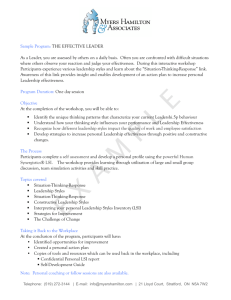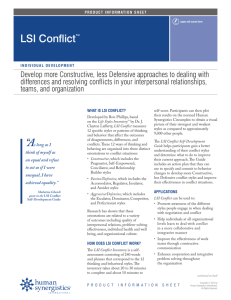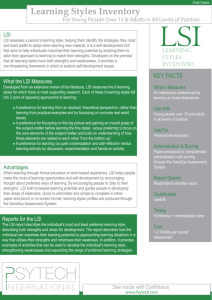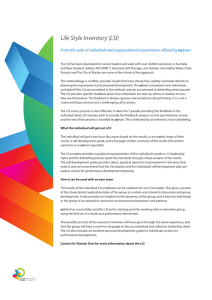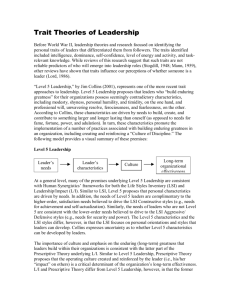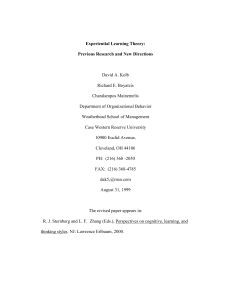7% primary or secondary
advertisement
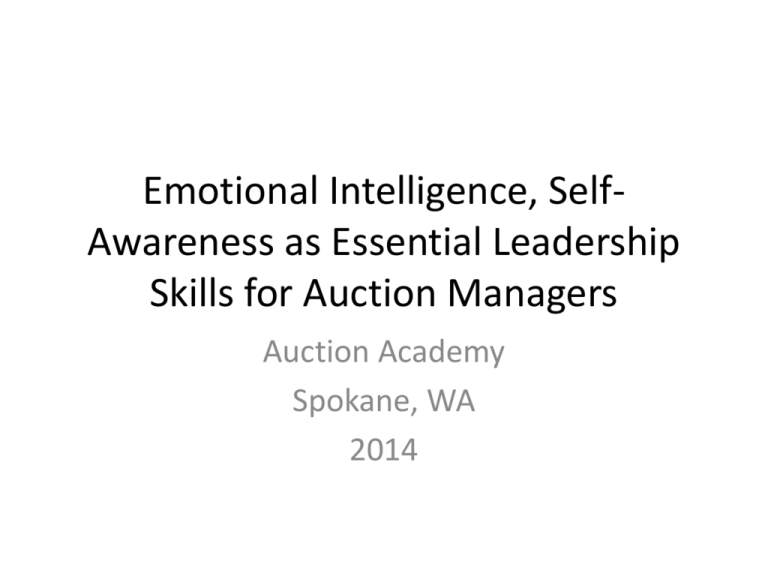
Emotional Intelligence, SelfAwareness as Essential Leadership Skills for Auction Managers Auction Academy Spokane, WA 2014 Objectives 1. To demonstrate that leadership skills are unique to themselves; a unique skillset not associated with technical acumen – EQ and the evolution of skills 2. To demonstrate that self-awareness is a keyattribute of successful managers and leaders 3. To grow in self-awareness using a selfassessment instrument (the LSI) GM’s new “Car Guy” Mary Barra Reflect • Think of a leader you admire, perhaps one that even inspires you. What are the traits or characteristics you most admire about this leader? • Write these down. Pop Quiz: True or False? In order to be an effective manager of a department or functional area, you must possess an advanced level of knowledge of the technical aspects and functions of the department, as well as a deep understanding of each job housed within the functional area. EQ not IQ Personal Competence • Self awareness – emotional awareness, accurate self-assessment, self confidence • Self regulation – managing impulses • Motivation – achievement, drive, commitment Social Competence • Empathy – understanding, developing others • Social skills – inducing desirable responses in others Pop Quiz: True or False? In order to be an effective manager of a department or functional area, you must possess an advanced level of knowledge of the technical aspects and functions of the department, as well as a deep understanding of each job housed within the functional area. Reliance on Tech Knowledge for Success high low Emp. Supervisor Mid Mgt. Mgt. Sr Mgt Exec The Evolution of Skillsets Line Employee: Supervisor: Manager: Vehicle Inspector Vehicle Inspection Lot Operations • Ability to evaluate vehicle to detect abnormalities, excessive damages • Ability to translated observations into quantifiable information • Skills: physical capability, knowledge of automobile construction, computer skills • Ability to plan, set realistic goals • Monitor output of functional area against stated standards • Prioritize tasks of employees • Ensure workers fulfill basic duties in accordance with company policies • Skills: communication, interpersonal, forecasting, monitoring, enforcing & interpreting policy • Plan for multiple functions, coordinating departmental activities • Ensure staffing levels are adequate • Translate employee issues to upper management • Ensure policies are adhered to, deal with employee issues • Skills: EQ 8 Essential Leadership Skills • Strategic thinking—anticipation, visioning, planning, implementing, monitoring, adjusting • The ability to inspire others toward a vision • Ability to “bring the customer to the boardroom” (customer centrism) • Ability to communicate clearly • Being flexible • Ability to attract and surround yourself with quality people • Ability to form trusting, nurturing relationships http://www.telegraph.co.uk/finance/jobs/9920854/Leadership-The-eight-essential-skills.html Exercise • Think of a specific nonproductive, damaging or even destructive behavior you see constantly exhibited by someone you know of or work for in a management position – Describe the behavior – Describe the reaction the behavior gets from employees – How did this person develop this behavior tendency or “pattern” Johari Window • Created in 1955 by two American psychologists (Joseph Luft and Harrington Ingham) • Used to help people better understand their relationship with self and others • Used as a tool to enhance self-awareness and improve communication skills Unknown to Self Unknown to Others Hidden or Shadow Self Blind Spots Know to others Known to Self Secret or Private Self Public Self or Façade: Area of Free Activity Unknown to Self Unknown to Others Know to others Known to Self Reduce hidden area by growing in self awareness and disclosure to others Blind Spots Reduced Reduce blind spots from feedback from others; increase area of free reign Behavioral “Patterns” • What is a “behavioral pattern”? – Somewhat stable and predictable action or mannerism designed to allow individuals to successfully interact with their environment – Can be conscious, subconscious, overt, covert, voluntary or involuntary • How are these formed? – Usually adaptive in nature…they worked in a variety of situations and became embedded as an acceptable response to certain stimuli Thought is the predecessor of behavior. Cognitive Shortcuts I cdn'uolt blveiee taht I cluod aulaclty uesdnatnrd waht I was rdanieg: the phaonmneel pweor of the hmuan mnid. Aoccdrnig to a rseearch taem at Cmabrigde Uinervtisy, it deosn't mttaer in waht oredr the ltteers in a wrod are, the olny iprmoatnt tihng is taht the frist and lsat ltteer be in the rghit pclae. The rset can be a taotl mses and you can sitll raed it wouthit a porbelm. Tihs is bcuseae the huamn mnid deos not raed ervey lteter by istlef, but the wrod as a wlohe. Amzanig huh? Yaeh and you awlyas thguoht slpeling was ipmorantt. Satisficing and Heuristics “Most decisions are concerned not with searching for the sharpest needle in the haystack, but with searching for a needle sharp enough to sew with. Thus, administrators who ‘satisfice’ can make decisions without a search for all possible alternatives and can use relatively simple rules of thumb (heuristics). In business terms they do not look for ‘maximum profit’ but ‘adequate profit’; not ‘optimum price’ but ‘fair price.’ This makes their world much simpler.” Pugh & Hickson, 1989 The LSI • Built on psychological and managerial theories • Helps you identify your beliefs, values, behaviors, and assumptions about yourself • Distinguishes between those that are effective and ineffective – Self defeating behaviors • Distinguishes between 12 LSI “styles” • Guide contains suggestions for addressing selfdefeating styles • Helps you set and accomplish self-improvement goals Thoughts Behavior Link • Thoughts and self-concepts drive behavior, shape your life • Self-concept is the image you have of yourself, you act in a manner that is consistent with your self-view • You can change your thoughts and views of self, thereby enhancing your effectiveness Where your scores came from • Three sections – LSI “Style” Items • 240 words and phrases you responded to (like you/not like you) – Satisfaction Items • 13 questions (1=not satisfied; 5=completely satisfied) – Summary Perceptions • 11 statements with opposites 240 Statements and Phrases Satisfaction Items Summary Perceptions 12 Styles – 3 Clusters 3 Clusters of Different Styles • Constructive – satisfaction oriented • Passive/Defensive – selfprotecting/security oriented through people • Aggressive/Defensive – selfprotecting/security oriented through tasks • http://www.humansynergistics.co m/Files/HTML5/Circumplex/index .html 12 Styles (Specific ways of thinking) • Humanistic/Encouraging • Affiliate • Approval • Conventional • Dependent • Avoidance • Oppositional • Power • Competitive • Perfectionistic • Achievement • Self-actualization % Total Class as Primary or Secondary Style Passive/Defensive 16% Constructive Aggressive/Defensive 14% 14% 14% 14% 12% 11% 11% 10% 8% 7% 7% 7% 6% 4% 4% 2% 0% 0% 4% 7% Styles and Relationships 3 Clusters 43% primary or secondary 3 Clusters 25% primary or secondary 3 Clusters 32% primary or secondary Humanistic—Encouraging 7% primary or secondary Affiliate 7% primary or secondary Approval 0% primary or secondary Conventional 4% primary or secondary Dependent 14% primary or secondary Avoidance 7% primary or secondary Oppositional 7% primary or secondary Power 4% primary or secondary Competitive 11% primary or secondary Perfectionistic 11% primary or secondary Achievement 14% primary or secondary Self-Actualizing 14% primary or secondary Percentiles: What do these indicate? 90th 75th 50th 25th 10th Looking at a Profile • • • • See profile as “snapshot” of yourself right now Confirms and enlightens Thought starters, not final declarations Think why you’ve developed a pattern, what was going on at the time the pattern was adopted • Expect change over time, and as situations change (i.e., a new job or position) Group Observations • Review your primary style in light of the table on page 61 • Reflect on your observations – Did anything you read strike you? – Do you see the need for self-development in any area? If so, describe. Behavior Change • Must be aware of strengths and weaknesses (self-awareness) • Accept self as you are now • Understand how your thinking and behavior affects others (self-awareness) • Deciding to improve • Committing to a plan of action Changing Behavior • Can be difficult, must be motivated to change such that incentive outweighs the inertia of the status quo • • • • • Follow these steps: Clearly articulate the issue Clearly articulate the desired behavior Develop a pathway forward Get professional help when needed (more ingrained and dysfunctional patterns are usually rooted in early childhood trauma and often require therapy to resolve) • Get a partner, friend, colleague to work with you Being Perfect 1. 2. 3. Where I am now: I plan things to death, and allow little ownership by others in the planning process Where I want to go: I want to engage others in the planning process so that they are motivated to own the outcomes to the degree that I am, yet ensure we deliver quality results How I plan to get there: a. Discuss my LSI results with a trusted co-worker and employee (I don’t trust my boss, and am afraid he’ll use my results against me in my performance review) • I’ll improve over a period of six months, and even more in one year b. c. d. 4. Ask co-workers and employee to point out my overly perfectionistic behaviors when they observe them Read the book titled “Overcoming Perfectionism: The Key to Balanced Recover” and journal on my reflections as I read the book Ask my best friend to help keep me accountable to reading the book and doing the work of letting go of my perfectionist tendencies How I will know I’ve arrived: I will receive feedback from my coworker, employee, and friend that they’ve observed change in me
